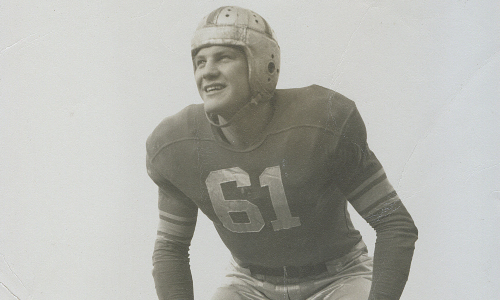Legacy Stories
Louis Creekmur
Louis “Lou” Creekmur was a Pro Football Hall of Fame offensive lineman and three-time NFL Champion for the Detroit Lions from 1950-1959. Creekmur was known for his legendary toughness. He played every single snap for eight straight NFL seasons, all without a facemask and often through several injuries. Creekmur was a successful businessman during and after his playing career, but began to suffer from cognitive, behavioral, and mood issues in the late 1970s. After his death in 2009 at age 82, he became the 10th former NFL player to be diagnosed with Chronic Traumatic Encephalopathy (CTE) by researchers at the VA-BU-CLF Brain Bank.

Lou Creekmur was unwaveringly loyal and relentlessly tough in everything he did. Creekmur was born on January 22, 1927 in Hopelawn, New Jersey. He went on to play college football at the College of William and Mary, but his football career was interrupted when he served in the US Army to fight in World War II in 1945 and 1946.

Creekmur returned to William & Mary and finished school before being acquired by the Detroit Lions prior to the 1950 NFL season. He immediately held the crucial responsibility of protecting Bobby Layne and Doak Walker, the Lions’ star quarterback and running back, respectively. Early in his first season, Creekmur felt Layne’s scorn after allowing a sack. He made a vow to his quarterback.
“I didn’t want to take the wrath of Bobby Layne. If I was going to stay in the league, I was going to block for Bobby Layne. I was going to do everything possible to not let any one of those defensive guys get to Bobby Layne,” said Creekmur in an NFL Films documentary.

He lived up to his word. Creekmur played every single snap in every practice, and all 165 preseason, regular season, and playoff game the Lions played from 1950-1958, including NFL Championship games. In many of those games, Creekmur was playing with at least one significant injury.
“I played one complete season with a crushed sternum and just put a pad over it… You were going to get paid on Monday, so I had to play on Sunday,” said Creekmur.
In addition to his litany of bone and muscle injuries, Creekmur also suffered several concussions in an era where offensive linemen led with their heads, not their hands. He and his last wife Caroline recounted “16 or 17” concussions in his career.

During Creekmur’s career, playing in the NFL wasn’t all that lucrative. He, like many of his peers, held day jobs during the football season. Creekmur was a manager at the Saginaw Transfer Co.
“There were many days when I’d make a call on a Monday morning after a football game with a black eye or a bloody nose or a cut across my forehead. For some reason, I was always let in to see the boss first,” said Creekmur.
After the 1958 season, Creekmur retired from football to focus on his business career. But after the Lions started out with a dismal 0-4 record in 1959, Creekmur’s iconic loyalty was on full display. The Lions called him back to play, and Creekmur obliged to help the Lions finish out the season. He officially retired from football after the 1959 season.

In 1996, Creekmur’s tenacious nature paid off once again. After years of urging, Creekmur was enshrined in the Pro Football Hall of Fame.
Creekmur went on to serve as the Public Relations Director of Ryder Systems, Inc. until his retirement. But in the late 1970’s, Creekmur began to experience cognitive and behavioral issues. His memory progressively faded, he grew inattentive, his executive functioning declined, and he became increasingly intense, angry, and aggressive. He was thought to be suffering from Alzheimer’s disease.

Lou Creekmur passed away on July 5, 2009 at age 82. After his death, his brain was studied by Dr. Ann McKee and the research team at the VA-BU-CLF Brain Bank. He became the 10th former NFL player diagnosed with Chronic Traumatic Encephalopathy (CTE).
“By examining his brain, I was able to confirm that there was absolutely no sign of Alzheimer's disease or any other type of neurodegenerative disease except for severe CTE. This is the most advanced case of CTE I've seen in a football player; his brain changes were similar to those of profoundly affected professional boxers,” said Dr. McKee in 2009.
Creekmur’s brain pathology helped show the world the toll a career in football could have. He will forever be known for his relentless offensive line play and his dedication to his country, his teammates, and his family.
You May Also Like

Living with suspected CTE can be difficult, but CTE is not a death sentence and it is important to maintain hope. Find out how.
Living with CTE
Although we cannot yet accurately diagnose CTE in living people, a specialist can help treat the symptoms presenting the most challenges.
CTE Treatments